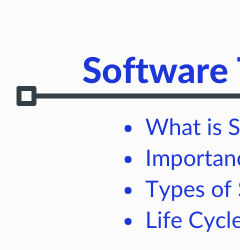15 Oct

Software testing is a necessary process to ensure that a program or an application works properly. Different testing methods are used to test various aspects of software. View all the types of software testing in detail:
➠ Manual Testing
When testing by hand, testers look at the software instead of those automated technologies. They mock users clicking through, replacing test cases, and watching what the application is doing. Manual testing is often used early in the development process or when verifying some user interactions or behaviours.
➠ Automation Testing
In automation testing, we use software tools to execute test cases. Develop scripts that can run tests automatically, and testers do not need to perform all manual steps. Automation testing is faster and offers more productivity benefits when performing tests for larger projects or regular procedures.
➠ Functional Testing
Why would you write code that does not work as intended? Functional testing tests whether a program behaves as expected. It mainly focuses on certain features or the system’s functionality to ensure they work according to requirements. For example, testing a login form using valid and invalid data to see whether it fulfilled its purpose may be part of functional testing.
➠ Non-Functional Testing
Unlike functional testing, non-functional testing does not test the functionalities of the software; instead, it decides how well the function works. Amongst this is how you test whether or not the software functions and how quickly it does. Some common types of non-functional testing are load testing, performance testing, security testing, etc.
➠ Unit Testing
Unit testing may also refer to the testing of an individual software module or component. Normally, developers have to write some codes to maintain a code base that is working well, as we are explaining our wish for the code. Similar to testing the individual parts of a building before turning it online.
➠ Integration Testing
It also talks about how different components/units interact with each other and is specifically referred to as integration testing. When each component has been properly tested, the integration testing then verifies that they run accurately together.
➠ System Testing
System testing involves doing it for the entire software system to check whether the system meets all specified requirements or not. It takes place after integration testing and is involved in testing the overall working of the system.
➠ Acceptance Testing
Acceptance testing is conducted to determine whether the software is good for production. It proves that the app can be accepted and adheres to the consumer or end-user requirements. A well-known example of this type of testing is User Acceptance Testing (UAT).
➠ Regression Testing
For those of you who are unfamiliar, regression testing serves to verify that modifications or enhancements to the code do not adversely impact functionality that already exists. You just know the developers must come in and touch things, so perform regression tests afterward to make sure everything still works as is.
➠ Smoke Testing
Smoke Testing: A quick way to find out whether the base functionalities of your software are working appropriately. It is commonly performed after a new build to verify that there are no serious problems, which could prevent it from functioning properly.
➠ Performance Testing
Performance testing assesses the performance of an application over various conditions, i.e., heavy loads or critical data volumes. It simply ensures that it can be run in the real world and identifies any operational choke points.
➠ Load Testing
Load testing This is what checks how your application works under heavy load. It makes certain that the program won’t crash during the processing of millions of users and records.
➠ Security Testing
The purpose of security testing is to identify the software vulnerabilities that can be maliciously exploited. It is the aim to protect the software in all aspects as well as attacks. Testers check whether passwords are strong enough and data is properly protected.
➠ Usability Testing
Usability testing offers the satisfaction of software users. They watch real users navigate the software and ask for their opinion on usability.
➠ Compatibility Testing
Software compatibility is tested to determine whether your software works effectively with any type of hardware, operating system, browser, version, and different configurations. Its access makes it an easy chore for users across all who can use the software.
Conclusion
Software testing is a vast field, having numerous types in it and functioning uniquely as well. These tests, on the one hand, aimed at the software’s realisation, and on the other, they were about its usability, security, or performance. With the help of these multiple testing techniques, a tester can make sure that the program is reliable, secure, and easy to use even before it hits the market.
You should have an understanding of all these types of testing if you are hoping to develop good-quality software meeting user and consumer expectations.




deepali